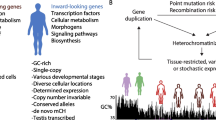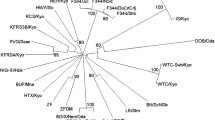Abstract
The mammalian olfactory system utilizes three large receptor families: the olfactory receptors (ORs) of the main nose and the vomeronasal type-1 and type-2 receptor genes (V1Rs and V2Rs) of the vomeronasal organ. We find that these loci are among the most long interspersed nuclear element (LINE)-dense regions of mammalian genomes. We investigate two evolutionary models to account for this cohabitation. First, we investigate an adaptive selection model, in which LINEs have contributed to expansions of mouse V1R repertoires. We find that even evolutionarily stable V1R loci are exceptionally LINE-rich compared to other genome loci, including loci containing other large gene clusters. Also, a more detailed analysis of specific V1R duplications does not reveal LINE patterns predicted by common LINE-mediated duplication mechanisms. Next, we investigate neutral models, in which LINEs were tolerated by, but not advantageous for, surrounding V1R genes. We find that V1R loci are exceptionally LINE-rich compared to other regions of similar AT base composition, and that duplicated V1R gene blocks are generally depleted of LINE elements, suggesting that these loci did not become densely populated with LINEs simply as a consequence of targeted integration or passive multiplication along with the genes. Finally, we show that individual LINE repeats of a given age at V1R, V2R, and OR loci exhibit a significantly longer average length than at other autosomal loci, suggesting a reduced tendency for these LINEs to be disrupted. We speculate that LINEs at V1R, V2R, and OR loci might be selectively retained because they contribute to allelic regulation of these three gene families.







Similar content being viewed by others
References
Abrusan G, Krambeck HJ (2006) The distribution of L1 and Alu retroelements in relation to GC content on human sex chromosomes is consistent with the ectopic recombination model. J Mol Evol 63:484–492
Allen E, Horvath S, Tong F, Kraft P, Spiteri E, Riggs AD, Marahrens Y (2003) High concentrations of long interspersed nuclear element sequence distinguish monoallelically expressed genes. Proc Natl Acad Sci USA 100:9940–9945
Babcock M, Pavlicek A, Spiteri E, Kashork CD, Ioshikhes I, Shaffer LG, Jurka J, Morrow BE (2003) Shuffling of genes within low-copy repeats on 22q11 (LCR22) by Alu-mediated recombination events during evolution. Genome Res 13:2519–2532
Bailey JA, Carrel L, Chakravarti A, Eichler EE (2000) Molecular evidence for a relationship between LINE-1 elements and X chromosome inactivation: the Lyon repeat hypothesis. Proc Natl Acad Sci USA 97:6634–6639
Boissinot S, Chevret P, Furano AV (2000) L1 (LINE-1) Retrotransposon evolution and amplification in recent human history. Mol Biol Evol 17:915–928
Buck LB (2004) Olfactory receptors and odor coding in mammals. Nutr Rev 62:S184–S188, discussion S224–S241
Buck L, Axel R (1991) A novel multigene family may encode odorant receptors: a molecular basis for odor recognition. Cell 65:175–187
Chess A, Simon I, Cedar H, Axel R (1994) Allelic inactivation regulates olfactory receptor gene expression. Cell 78:823–834
Dulac C, Axel R (1995) A novel family of genes encoding putative pheromone receptors in mammals. Cell 83:195–206
Ensminger AW, Chess A (2004) Coordinated replication timing of monoallelically expressed genes along human autosomes. Hum Mol Genet 13:651–658
Feng Q, Moran JV, Kazazian HH Jr, Boeke JD (1996) Human L1 retrotransposon encodes a conserved endonuclease required for retrotransposition. Cell 87:905–916
Gasior SL, Wakeman TP, Xu B, Deininger PL (2006) The human LINE-1 retrotransposon creates DNA double-strand breaks. J Mol Biol 357:1383–1393
Gibbs RA, Weinstock GM, Metzker ML et al (2004) Genome sequence of the Brown Norway rat yields insights into mammalian evolution. Nature 428:493–521
Grus WE, Shi P, Zhang YP, Zhang J (2005) Dramatic variation of the vomeronasal pheromone receptor gene repertoire among five orders of placental and marsupial mammals. Proc Natl Acad Sci USA 102:5767–5772
Hardies SC, Martin SL, Voliva CF, Hutchison CA, Edgell MH (1986) An analysis of replacement and synonymous changes in the rodent L1 repeat family. Mol Biol Evol 3:109–125
Herrada G, Dulac C (1997) A novel family of putative pheromone receptors in mammals with a topographically organized and sexually dimorphic distribution. Cell 90:763–773
Hurles M (2004) Gene duplication: the genomic trade in spare parts. PLoS Biol 2:E206
Jukes JA, Cantor CR (1969) Evolution of protein molecules. Academic Press, New York
Kambere MB, Lane RP (2007) Co-regulation of a large and rapidly evolving repertoire of odorant receptor genes. BMC Neurosci 8(Suppl 3):S2
Keverne EB (2002) Mammalian pheromones: from genes to behaviour. Curr Biol 12:R807–R809
Lane RP, Cutforth T, Axel R, Hood L, Trask BJ (2002) Sequence analysis of mouse vomeronasal receptor gene clusters reveals common promoter motifs and a history of recent expansion. Proc Natl Acad Sci USA 99:291–296
Lyon MF (2003) The Lyon and the LINE hypothesis. Semin Cell Dev Biol 14:313–318
Matsunami H, Buck LB (1997) A multigene family encoding a diverse array of putative pheromone receptors in mammals. Cell 90:775–784
Olender T, Fuchs T, Linhart C, Shamir R, Adams M, Kalush F, Khen M, Lancet D (2004) The canine olfactory subgenome. Genomics 83:361–372
Pascale E, Liu C, Valle E, Usdin K, Furano AV (1993) The evolution of lone interspersed repeated DNA (L1, LINE 1) as revealed by the analysis of an ancient rodent L1 DNA family. J Mol Evol 36:9–20
Pastink A, Eeken JC, Lohman PH (2001) Genomic integrity and the repair of double-strand DNA breaks. Mutat Res 480–481:37–50
Rodriguez I, Feinstein P, Mombaerts P (1999) Variable patterns of axonal projections of sensory neurons in the mouse vomeronasal system. Cell 97:199–208
Rodriguez I, Del Punta K, Rothman A, Ishii T, Mombaerts P (2002) Multiple new and isolated families within the mouse superfamily of V1r vomeronasal receptors. Nat Neurosci 5:134–140
Ryba NJ, Tirindelli R (1997) A new multigene family of putative pheromone receptors. Neuron 19:371–379
Serizawa S, Ishii T, Nakatani H, Tsuboi A, Nagawa F, Asano M, Sudo K, Sakagami J, Sakano H, Ijiri T, Matsuda Y, Suzuki M, Yamamori T, Iwakura Y, Sakano H (2000) Mutually exclusive expression of odorant receptor transgenes. Nat Neurosci 3:687–693
Shoja V, Zhang L (2006) A roadmap of tandemly arrayed genes in the genomes of human, mouse, and rat. Mol Biol Evol 23:2134–2141
Singh N, Ebrahimi FA, Gimelbrant AA, Ensminger AW, Tackett MR, Qi P, Gribnau J, Chess A (2003) Coordination of the random asynchronous replication of autosomal loci. Nat Genet 33:339–341
Smit AF, Toth G, Riggs AD, Jurka J (1995) Ancestral, mammalian-wide subfamilies of LINE-1 repetitive sequences. J Mol Biol 246:401–417
Tan SS, Williams EA, Tam PP (1993) X-chromosome inactivation occurs at different times in different tissues of the post-implantation mouse embryo. Nat Genet 3:170–174
Tharapel AT, Michaelis RC, Velagaleti GV, Laundon CH, Martens PR, Buchanan PD, Teague KE, Tharapel SA, Wilroy RS Jr (1999) Chromosome duplications and deletions and their mechanisms of origin. Cytogenet Cell Genet 85:285–290
van den Bosch M, Lohman PH, Pastink A (2002) DNA double-strand break repair by homologous recombination. Biol Chem 383:873–892
Voliva CF, Jahn CL, Comer MB, Hutchison CA, Edgell MH (1983) The L1Md long interspersed repeat family in the mouse: almost all examples are truncated at one end. Nucleic Acids Res 11:8847–8859
Waterston RH, Lindblad-Toh K, Birney E et al (2002) Initial sequencing and comparative analysis of the mouse genome. Nature 420:520–562
Yang H, Shi P, Zhang YP, Zhang J (2005) Composition and evolution of the V2r vomeronasal receptor gene repertoire in mice and rats. Genomics 86:306–315
Young JM, Friedman C, Williams EM, Ross JA, Tonnes-Priddy L, Trask BJ (2002) Different evolutionary processes shaped the mouse and human olfactory receptor gene families. Hum Mol Genet 11:535–546
Young JM, Kambere M, Trask BJ, Lane RP (2005) Divergent V1R repertoires in five species: amplification in rodents, decimation in primates, and a surprisingly small repertoire in dogs. Genome Res 15:231–240
Zhang X, Firestein S (2002) The olfactory receptor gene superfamily of the mouse. Nat Neurosci 5:124–133
Acknowledgments
This work was supported by National Institutes of Health Grant R01-DC006267. We thank Andrew Chess and Scott Holmes for their thoughtful comments on the manuscript.
Author information
Authors and Affiliations
Corresponding author
Electronic supplementary material
Rights and permissions
About this article
Cite this article
Kambere, M.B., Lane, R.P. Exceptional LINE Density at V1R Loci: The Lyon Repeat Hypothesis Revisited on Autosomes. J Mol Evol 68, 145–159 (2009). https://doi.org/10.1007/s00239-008-9195-0
Received:
Revised:
Accepted:
Published:
Issue Date:
DOI: https://doi.org/10.1007/s00239-008-9195-0




